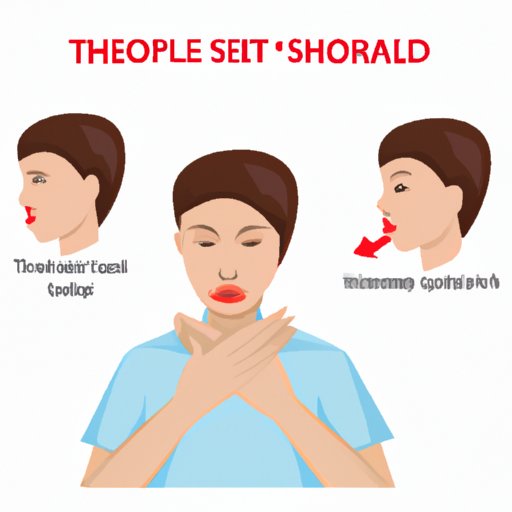
Introduction
Strep throat is a bacterial infection that affects the throat and tonsils. While most people experience a sore throat from time to time, it’s important to recognize the symptoms of strep throat and seek medical attention if necessary. In this article, we’ll explore the most common symptoms of strep throat and what you can do to prevent and treat the infection.
10 Common Symptoms of Strep Throat: Know When to Seek Medical Attention
The symptoms of strep throat can vary from person to person, but some of the most common signs to look out for include:
Sore Throat
One of the most identifiable symptoms of strep throat is a sore throat. This symptom can range from mild to severe and may make it difficult to swallow or talk.
Difficulty swallowing
Difficulty swallowing is another common symptom of strep throat. You may feel as if there’s a lump in your throat, making it hard to take in food and liquids.
Fever
Fever is a common sign of infection, and strep throat is no exception. If you have a fever that’s 101 degrees Fahrenheit or higher, it could be a sign that you have strep throat.
Chills
Chills are another symptom of strep throat that often accompany a fever. You may feel cold and shiver, even if you’re wearing warm clothing.
Headache
Headaches are a common symptom of many illnesses, including strep throat. If you have a headache and other symptoms of strep throat, it’s important to seek medical attention.
Nausea
Nausea is common with strep throat, and you may feel like vomiting. This symptom is more common in children than in adults.
Vomiting
Vomiting can occur with strep throat, and it’s another reason why it’s important to seek medical attention if you’re experiencing symptoms.
Swollen lymph nodes
Strep throat can cause the lymph nodes in your neck to become swollen and painful. This symptom may make it difficult to move your neck or turn your head.
Redness at the back of the throat
If you have strep throat, you may notice redness and swelling at the back of your throat. This can make it difficult to swallow or talk.
Rash
A rash is a less common symptom of strep throat, but it can occur in some cases. The rash may be red or pink and may appear on your neck, chest, and stomach.
Is It Strep Throat? Symptoms to Look Out For
It can be difficult to differentiate between strep throat and other illnesses, such as the common cold. Here are some common symptoms to look out for:
Differentiating between strep throat and other illnesses
While strep throat can mimic the symptoms of other illnesses, there are some key differences to look out for. For example, strep throat is more likely to cause a sudden and severe sore throat, as well as swollen lymph nodes.
Description of symptoms
In addition to the symptoms listed above, strep throat may also cause fatigue, body aches, and a loss of appetite.
When to see a doctor
If you’re experiencing symptoms of strep throat, it’s important to see a doctor. A throat culture or rapid strep test can determine if you have strep throat, and your doctor can prescribe antibiotics to treat the infection.
The Dreaded Strep Throat: Recognizing Symptoms and Seeking Treatment
Strep throat is a contagious infection that can be severe if left untreated. Here’s what you need to know:
Explanation of the severity of strep throat
Strep throat can lead to more serious health complications if left untreated. These complications can include rheumatic fever, kidney inflammation, and infections in other parts of the body.
Importance of early treatment
Early treatment is key to preventing complications of strep throat. If you’re experiencing symptoms, it’s important to see a doctor as soon as possible.
Overview of treatment options
Antibiotics are the most common treatment for strep throat. Your doctor may also recommend over-the-counter pain relievers to help alleviate symptoms.
How to Tell If You Have Strep Throat: Key Symptoms to Watch For
Here are some key symptoms to watch for if you suspect you have strep throat:
Descriptions of key symptoms
In addition to the symptoms listed above, you may also experience a loss of appetite, swollen tonsils, and white patches on your tonsils or throat.
Importance of monitoring symptoms
It’s important to monitor your symptoms and seek medical attention if they worsen or don’t improve after a few days.
Self-care tips
In addition to seeing a doctor, there are some self-care tips you can follow to help alleviate symptoms. These include getting plenty of rest, drinking fluids, and avoiding irritants such as smoke, fumes, and cleaning products.
Strep Throat 101: Understanding the Symptoms and Getting the Right Diagnosis
Here’s what you need to know about the basics of strep throat:
Overview of strep throat
Strep throat is caused by bacteria and is highly contagious. It can be spread through contact with an infected person’s saliva or nasal secretions.
Causes of strep throat
Strep throat is caused by the Streptococcus pyogenes bacteria. This bacteria is highly contagious and can be spread through contact with an infected person’s saliva or nasal secretions.
Diagnosis process
A throat culture or rapid strep test can determine if you have strep throat. Your doctor may also examine your throat and ask about your symptoms.
Preventive measures
The best way to prevent strep throat is to practice good hygiene, such as washing your hands frequently and avoiding close contact with infected individuals.
Conclusion
Strep throat is a contagious infection that can cause a range of symptoms, from a sore throat and difficulty swallowing to fever and chills. It’s important to seek medical attention if you suspect you have strep throat, as early treatment can help prevent complications. By monitoring your symptoms and practicing good hygiene, you can help protect yourself from strep throat and other illnesses.




